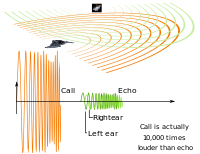
Photo from wikipedia
Passive acoustic monitoring records large amounts of acoustic data, and thus an efficient detection method is essential to analyse these data. A novel approach is proposed to automatically detect odontocete… Click to show full abstract
Passive acoustic monitoring records large amounts of acoustic data, and thus an efficient detection method is essential to analyse these data. A novel approach is proposed to automatically detect odontocete echolocation clicks. A time–frequency filter detects echolocation clicks in the time–frequency domain, and then the Teager–Kaiser energy operator and Gabor curve-fitting method determine the start and end points of each echolocation click precisely. Detector performance is assessed by using synthetic data. The experimental results showed that the recall rates were higher than 90% when the signal-to-noise ratio was above 10 dB.
Journal Title: Electronics Letters
Year Published: 2017
Link to full text (if available)
Share on Social Media: Sign Up to like & get
recommendations!